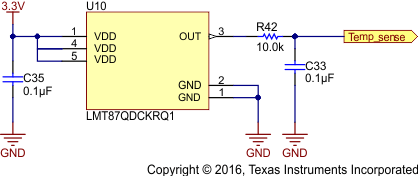TIDUCL0 January 2017
- 1 Description
- 2 Resources
- 3 Features
- 4 Applications
- 5 Design Images
- 6 System Overview
-
7 System Design Theory
- 7.1 Power Stage Design—Battery Power Input to the Board
- 7.2 Power Stage Design—Three-Phase Inverter
- 7.3 Power Stage Design—DRV8323 Gate Driver
- 7.4 Power Stage Design—18-V to 3.3-V DC-DC Converter
- 7.5 Power Stage Design —Microcontroller MSP430
- 7.6 Power Stage Design—Hall Sensor Interface
- 7.7 Temperature Sensing
- 7.8 Power Stage Design—External Interface Options and Indications
- 8 Getting Started Hardware and Software
- 9 Testing and Results
- 10Design Files
- 11Software Files
- 12Related Documentation
- 13Terminology
- 14About the Author
7.7 Temperature Sensing
Figure 10 shows the temperature sensor circuit used to measure the PCB temperature. The LMT87 is an analog output temperature sensor. The temperature sensing element is comprised of a simple base emitter junction that is forward biased by a current source. The temperature sensing element is then buffered by an amplifier and provided to the OUT pin. The amplifier has a simple push-pull output stage, thus providing a low-impedance output source. The average output sensor gain is 13.6 mV/°C.
The temperature sensor placed near the MOSFET and the output of the temperature sensor is used to calibrate the VDS sense signal. The RDS_ON of the MOSFET varies with temperature and hence the VDS measured across the FET for current sensing has to be calibrated to measure the current accurately by sensing VDS.
NOTE
The temperature gradient in the board must be considered to properly calibrate the VDS of multiple FETs against RDS_ON variation with temperature.
 Figure 10. Temperature Sensor Schematic
Figure 10. Temperature Sensor Schematic